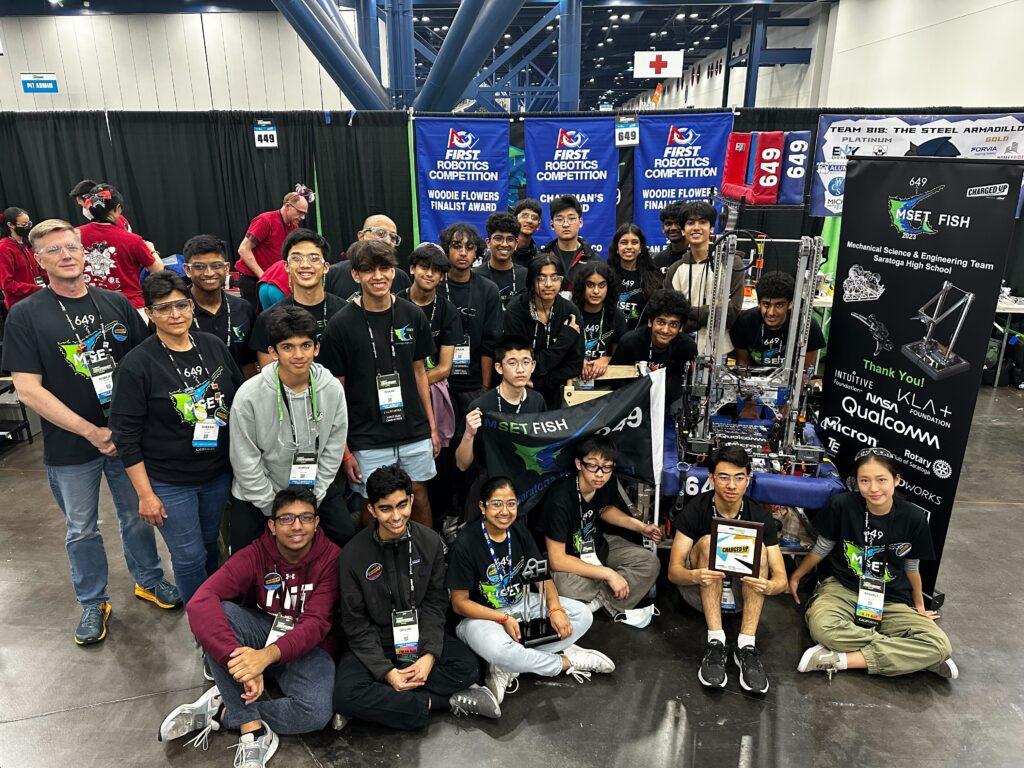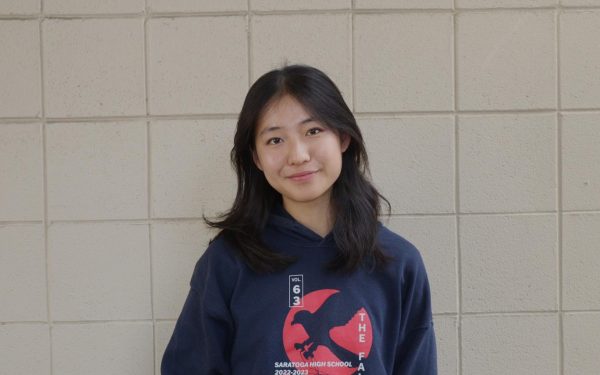On April 19, 27 of 47 students from the school’s FIRST Robotics Competition (FRC) team, 649 MSET Fish, boarded a plane to Houston to attend their second FIRST World Championship in a row — capping off the team’s most successful season yet.
For the rest of the week, the team competed in the George R. Brown Convention Center, swimming their way to the finals. Within their assigned division — the Curie Division — the team’s countless hours of work and modifications came to fruition: They seeded 17th out of 78 teams, and were picked to play with the first ranked alliance.
The team qualified for the World Championship after winning the regional Engineering Inspiration award at the Silicon Valley Regional (SVR) as a result of nearly every student on the team giving time to organize and volunteer at the outreach program’s various initiatives.
Led by students, the program’s initiatives include robotics mentorship programs, STEM labs, STEM education advocacy and car retro fittings to encourage mobility for children with disabilities. The award celebrates “outstanding success in advancing respect and appreciation for engineering within a team’s school or organization and community.” At SVR, the team seeded 26th out of 59 teams and joined the sixth ranked alliance, getting eliminated in the fourth of five semifinal rounds.
Before SVR, the team had less than three weeks following their first regional competition to incorporate an entirely new mechanism — a jointed roller that allowed the robot to pick up cubes from the ground.
“The addition of a ground intake [on our robot] allowed us to be less dependent on the skills of other teams when it came to [scoring three game pieces in a row], which weakened the effect of poor matchups at both SVR and Worlds,” said Owen Liang, a junior who is part of the hardware team. “The ability to do quick cycles [of picking up and scoring game elements] was something top teams look for when creating alliances, and was the deciding factor for being the second pick of the first seed alliance in our division at the World Championships.”
Following their second regional competition, the team faced much stiffer competition from world-class teams such as The Cheesy Poofs from Bellarmine and Spartan Robotics from Mountain View, and while they gained valuable knowledge from observing and asking questions about other team’s robots, they also realized that changes needed to be made to improve their speed, reliability and autonomous scoring capability. In total, more than 10 hardware, software and electronic fixes — ranging from maintenance to entirely new mechanisms — were completed.
The three days the team had between when regional competitions ended and when the robot needed to be shipped to Houston were dedicated to maintenance on the drivetrain and electronics, adding a slope on the plastic covering the drivetrain to prevent game elements from getting stuck, with a focus on software improvements. The team prioritized tuning autonomous paths, adding a 180-degree orientation lock for ease of scoring and pickup as well as programming a dunking routine in the arm for higher scoring accuracy.
“I’ve seen the new autonomous paths increase flexibility for our strategy,” said junior Govind Buttar, the team’s software lead . “We were less restricted to our middle starting configuration, and scored more points during the autonomous period [at the World Championships].”
The main objective of this year’s FRC game consisted of robots picking up and scoring cubes and cones, which required precise alignment either on the part of the human robot drivers — juniors hardware lead Naveed Kasnavi and hardware member Owen Liang — or an autonomous alignment algorithm.
At the beginning of the season, the team chose to give priority to driver practice, so autonomous aligning was put on hold, and Kasnavi and Liang manually aligned the robot for both scoring and pickup. But after their second regional, the team found that the manual alignment process was taking too much time during matches, restricting the number of elements they could score.
As a result, major software modifications aimed to increase the robot’s driveability, a huge factor in navigating traffic during matches and increasing scoring accuracy.
Once the software changes were made, the team moved their playing field from the MAP Annex to the band room to fit a full-length field that better simulated a field at the real tournament. They spent 20 hours on driver practice in the bigger space. The robot was shipped on April 13, around a week before the tournament, so the drivers needed to get used to the maneuverability of the robot before then.
When the team arrived at the Curie Division Tournament — one of eight World Divisions in Houston — they seeded 17th of 78 teams and formed an alliance (a group of three teams that play together, chosen round-robin-style for playoffs but randomly generated during qualification matches) with the first and second-seeded teams: team 5940 BREAD from Design Tech High in Redwood City and team 1756 Argos from Limestone Community High in Peoria, Illinois.
Unlike in previous years, other than during finals, the team rarely had to fix the robot between matches, only facing mechanical failures during their finals matches, whether it be with wiring or physical mechanisms. Although the team fell to the lower bracket of two during the double elimination-style playoffs, they still found their way to the finals after achieving a record-high score for their division during their last semifinal match.
The team made it all the way to their division finals, just two wins away from reaching the Einsteins tournament — a separate division where all eight initial division winners compete to bring home the title of “World Champion.”
However, the team lost their first finals match with a score of 204-207, making their next match a make-or-break.
“The close point gap served as a reminder that we couldn’t afford to play as conservative as we had in the earlier matches,” Liang said.
With alliance captain team 5940’s help in quickly manufacturing new parts, the team was able to replace their intake before the next deciding match. During that match, however, the robot suffered a hard drop as a result of accelerating off of a jointed three-piece bridge in the middle of the field and suddenly began to spin out of control, ending the team’s FRC season just a hair away from reaching Einstein’s.
Nevertheless, this year, the team got further than ever before in its two-decade history of competing in FRC, which is credited to the team’s countless hours of work and efficiency in prioritizing necessary changes.
“Overall, I would say that the robot performed better than initially expected,” Buttar said. “The team was able to use the lessons learned from [our first regional] effectively and utilize our remaining time to solve our biggest weaknesses going into SVR and the World Championships.”




























